Alien invasion
Be cautious of what you grow in your garden...
By Dhaneshi YATAWARA
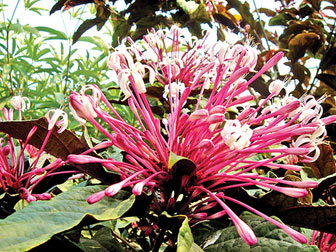 |
|
The Valentine plant |
Did you know that those gorgeous plants which decorate your garden
may harm the environment at some point if released to the wild?
According to researchers, many of the plants that upset the natural
balance of the environment were those introduced to Sri Lanka as
ornamental plants, e.g. Water hyacinth.
According to research done by Director General of the Department of
Botanical Gardens Dr. Siril Wijesundara, nine plant species commonly
used as ornamental plants have the potential of becoming invasive plants
- if grown irresponsibly. Today these plants can be seen growing in
natural eco-systems after having escaped their gardens.
Namely, the Indian cork tree, Parrot feather, Stream bog moss, Glory
bush, Mosaic plant, Donkey grass or Creeping guinea grass, Bristly
foxtail grass, Valentine plant and Arabian wax cissus are the nine
plants that are thriving in the environment. Research has revealed
alarming facts about these ornamental plants.
Such troublesome plants mostly arrive in the country through humans
and the majority are brought here as ornamental plants. Having no sense
of the would-be impact on the environment, people would just throw these
plants away once they start growing too fast. In next to no time they
grow rapidly over a vast area, outside the gardens, from where they were
dumped, and become invasive in the natural eco-system.
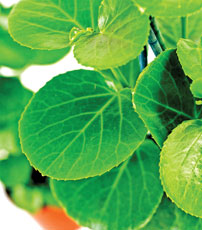 |
|
Arabian wax cissus |
Botanists call them Invasive Alien Species as these plants are alien
to the eco-system, having being introduced from a totally different
environment. Today Invasive Alien Species (IAS) have become a global
menace. These plant species, when introduced in a new location, spread
outside their natural habitats, causing deleterious effects on organisms
that already exist there. Most of these invasive plant species colonise
in areas with high levels of human disturbance, but many have also been
apparently invading undisturbed eco-systems, and threatening many of the
endangered indigenous species and habitats with extinction.
Water hyacinth (Eichhornia crassipes) Japan Jabara is one of the best
examples of an ornamental plant which became a menace to aquatic
eco-systems.
This aquatic plant species was introduced to Sri Lanka in 1905, to
the Royal Botanical Gardens, Peradeniya. Lady Edith Blake, wife of the
10th British Governor of Sri Lanka Sir Henry Arthur Blake brought this
aquatic plant to Sri Lanka from Hong Kong as an ornamental plant. It was
first planted in the Peradeniya Gardens. Sir Blake, before being posted
to Sri Lanka, was the Governor in Hong Kong from 1898 to 1903. He
governed Sri Lanka from 1903 to 1907.
As Dr. Wijesundara explained, quoting historical records, by June
1912 Water hyacinths had been reported from Wattegama in the Central
Province. In 1914 it had appeared near Tangalle in the Southern Province
and two years later, in Chilaw in the North Western Province. By 1917 it
was found in the Sabaragamuwa Province.
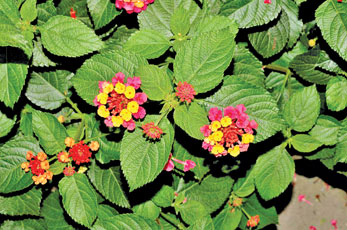 |
|
Lantana |
"As a means of controlling this aquatic plant, four ordinances were
enacted in 1930. They were the Water Hyacinth Ordinance No. 4 of 1909,
Plant Protection Ordinance No. 10 of 1924, Village Communities Ordinance
No. 9 of 1914 and Irrigation Ordinance No. 45 of 1917," said
Dr.Wijesundara quoting earlier research details.
Possible threats
One of the commonest ornamental plants growing in the wild is the
Valentine plant (Clerodendrum quadriloculare). Native to the
Philippines, this ornamental plant is grown in many parts of Sri Lanka
and blooms in February, hence its name. As a result of careless growing
by gardening lovers the plant is fast spreading in the wild. It is
considered an invasive plant of the highest priority on the Hawaiian
Islands.
The Indian cork tree (Millingtonia hortensis), belonging to the
Bignoniaceae family, is a plant native to South East Asia. It flourishes
in the dry zone and is seen mostly in degraded sites in Embilipitiya and
Thanamalwila areas.
Aquatic plant
Another aquatic plant called Parrot feather (Myriophyllum aquaticum)
grows well in the montane zone. This is a native aquatic plant of the
Amazon river in South America.
 |
|
Ulex - an invasive
gorse in the Horton Plains |
According to Sri Lankan researchers, this has been reported growing
out of home gardens in the Gregory's Lake in Nuwara Eliya. This is seen
as an invasive plant in many countries including USA, Pacific Islands,
Japan, New Zealand, South Africa and several European countries.
Mayaca fluviatilis, commonly known as Stream bog moss is also an
aquatic plant. It has been reported from water bodies in the vicinity of
Gampaha and is believed to have been thrown away or escaped from home
gardens. Mosaic plant (Ludwigia sedoides) is another aquatic ornamental
plant which has escaped in to the wild, and is mostly seen in the
vicinity of Gampaha. The plant is ideal for the wet zone.
Glory bush (Tibouchina urvilleana) is another ornamental plant which
people should carefully grow. One can find a glory bush thicket near the
Anderson bungalow in Horton Plains. Glory bush is native to Southern
Brazil and is reported to be invasive in Hawaii and some Pacific
Islands.
Donkey grass or Creeping guinea grass (Panicum trichocladum), a
native grass from Africa imported as a pasture grass, is found to be
spreading in Hanguranketha, Pelmadulla and Kadawatha areas. Bristly
foxtail grass (Setaria barbata) is another grass native to Africa which
is now spreading in the wet zone. Another invasive plant would be the
Arabian wax cissus (Cissus rotundifolia) native to Africa.
According to the study, 31 plant species are found to have already
invaded our eco-systems, causing havoc. Cuscuta, Lantana, Mimosa,
Opuntia and Salvinia are some of those invasive plants that have become
a menace.
Invading nature
According to Dr. Wijesundara's study, these invasive plants could be
in the form of herbs, shrubs, creepers or trees. They may invade
terrestrial or aquatic eco-systems. Some of these species such as
Cuscuta are parasitic. According to available data, most of these
invasive alien plants reported from Sri Lanka are vascular plants.
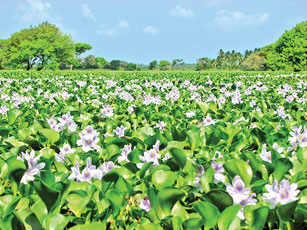 |
|
Water hyacinth |
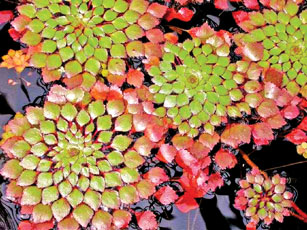 |
|
Ludwigia |
Alien plant species could be deliberately introduced when they are
useful, interesting or ornamental, and also imported through standard
institutions.
"Some plants, which have been deliberately introduced for a specific
purpose, have escaped from their compounds and become invasive," Dr.
Wijesundara said.
As he explained, Salvinia was introduced to Sri Lanka in the late
1930s as educational material, but appears to have escaped and is
currently one of the most troublesome aquatic invasive plants, blocking
irrigation canals and water bodies and also invading aquatic
eco-systems.
The other example, the giant mimosa (Mimosa pigra) is believed to
have been introduced to Sri Lanka in the early 1980s to strengthen the
river banks in the Mahaweli areas. Today it has spread to other parts of
the country by irrigation water, machinery, river sand used for
construction purposes as well as through lopped off branches with mature
pods as a result of the use of the stems of the plant as firewood by
people.
Such plants need to be treated with special care and propagated by
artificial aid. When a plant becomes independent of artificial aid of
any kind, and thrives in the wild after escaping its cultivation, it can
develop in to an invasive level.
"Invasion can be considered as an integral part of the evolution
process and deliberate plant introductions date back to the early days
of human civilisation," said Dr. Wijesundara, explaining that even the
origin of some of the most useful crops grown all over the world are
still unknown.
"When growing plants brought from other countries, people must first
understand the impact their characteristics will have on our nature. If
it is negative it is very important to grow these plants ensuring that
they will not be dumped carelessly," Dr. Wijesundara said.
Thus, it is vital to be careful and responsible when growing these
wonderful plants in your garden as a plant that looks lovely may not
actually fit into our eco-system; worse, it could harm and destroy the
existing environment.
|

